Comparing fertilizer prices in Poland and other EU countries is essential for understanding the agricultural landscape and the economic pressures faced by farmers. Fertilizers are a critical component of modern agriculture, influencing crop yields and overall farm productivity. This article delves into the factors affecting fertilizer prices, the current market situation in Poland, and how it compares to other EU nations.
Factors Influencing Fertilizer Prices
Several factors contribute to the fluctuations in fertilizer prices across different countries. Understanding these factors is crucial for farmers, policymakers, and stakeholders in the agricultural sector. Here are some of the primary influences:
- Raw Material Costs: The prices of raw materials used in fertilizer production, such as natural gas, phosphate rock, and potash, significantly impact the final cost of fertilizers. Changes in global commodity prices can lead to increased production costs.
- Supply Chain Dynamics: The efficiency of the supply chain, including transportation and logistics, plays a vital role in determining fertilizer prices. Disruptions in supply chains, such as those caused by geopolitical tensions or natural disasters, can lead to price spikes.
- Government Policies: Subsidies, tariffs, and regulations imposed by governments can affect fertilizer prices. For instance, countries that provide subsidies to farmers may see lower prices, while those with high tariffs on imports may experience increased costs.
- Market Demand: The demand for fertilizers is closely tied to agricultural production levels. In years of high crop yields, the demand for fertilizers may increase, leading to higher prices. Conversely, a poor harvest can reduce demand and lower prices.
- Environmental Regulations: Stricter environmental regulations aimed at reducing the use of chemical fertilizers can impact production costs and availability, thereby influencing prices.
Current Fertilizer Prices in Poland
As of 2023, Poland has experienced significant fluctuations in fertilizer prices, influenced by both domestic and international factors. The Polish agricultural sector relies heavily on fertilizers to maintain productivity, and any changes in prices can have a direct impact on farmers’ profitability.
In recent years, the prices of nitrogen, phosphorus, and potassium fertilizers have seen notable increases. For instance, the price of nitrogen fertilizers has risen due to higher natural gas prices, which are a key input in their production. Phosphate and potash prices have also been affected by global supply chain issues and increased demand from other countries.
According to recent data, the average price of nitrogen fertilizers in Poland is approximately 1,800 PLN per ton, while phosphorus and potassium fertilizers are priced at around 2,200 PLN and 2,000 PLN per ton, respectively. These prices are subject to change based on market conditions and external factors.
Comparison with Other EU Countries
When comparing fertilizer prices in Poland with those in other EU countries, several trends emerge. Countries such as Germany, France, and the Netherlands often have higher fertilizer prices due to their advanced agricultural practices and higher production costs. For example, the average price of nitrogen fertilizers in Germany can reach up to 2,200 PLN per ton, while in France, it may be around 2,000 PLN per ton.
On the other hand, some Eastern European countries, such as Hungary and Romania, tend to have lower fertilizer prices, often due to lower production costs and government subsidies. In Hungary, nitrogen fertilizers are priced at approximately 1,600 PLN per ton, making them more affordable for local farmers.
Impact on Polish Farmers
The rising costs of fertilizers have significant implications for Polish farmers. As input costs increase, farmers must find ways to maintain profitability while ensuring high crop yields. This situation has led many farmers to explore alternative practices, such as precision agriculture and organic farming, which may reduce their reliance on chemical fertilizers.
Additionally, the government has recognized the challenges posed by rising fertilizer prices and has implemented various support measures. These include financial assistance programs, subsidies for fertilizer purchases, and initiatives aimed at promoting sustainable agricultural practices.
Future Outlook
The future of fertilizer prices in Poland and the EU remains uncertain, influenced by a myriad of factors. As global demand for food continues to rise, the pressure on fertilizer prices is likely to persist. Farmers will need to adapt to these changes by exploring innovative solutions and sustainable practices to ensure their long-term viability.
Moreover, ongoing geopolitical tensions and environmental concerns may further complicate the fertilizer market. Policymakers will need to balance the need for affordable fertilizers with the imperative of sustainable agricultural practices to protect the environment and ensure food security.
Conclusion
In conclusion, the comparison of fertilizer prices in Poland and other EU countries reveals a complex interplay of factors that influence the agricultural sector. While Polish farmers face challenges due to rising costs, there are opportunities for innovation and adaptation. By understanding the dynamics of the fertilizer market, stakeholders can make informed decisions that support sustainable agricultural practices and ensure the long-term success of the farming community.




